Daffodil Classifications

What are those numbers and letters?
What are all those number and letter combinations that appear in daffodil catalogues? The NDSNZ follows the Royal Horticulture Society’s (RHS) daffodil classification system. In 1975, the RHS adopted a colour code system devised by American Dr. Tom Throckmorton. The letter refers to the colours of the daffodil as follows:
| W – White or Whitish |
| G – Green |
| Y – Yellow |
| P – Pink |
| O – Orange |
| R – Red |
All daffodils are classified into one of thirteen divisions. Each daffodil cultivar or garden hybrid belongs to one of the first twelve divisions. Those daffodils distinguished solely by botanical name belong in Division 13.
Below are the definitions for each Division along with a photo. Click on the photo to enlarge.
Miniatures have the same descriptive divisions as standards, only with smaller blooms, usually less than 50 mm in diameter (see photo at the bottom of this page).
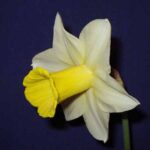
Division 1 – Trumpet Daffodils
One flower to a stem; corona (“trumpet”) as long as, or longer than the perianth segments (“petals”).

Division 2 – Large-Cupped Daffodils
One flower to a stem; corona (“cup”) more than one-third, but less than equal to the length of the perianth segments (“petals”)
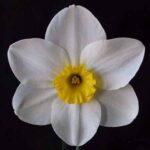
Division 3 – Small-Cupped Daffodils
One flower to a stem; corona (“cup”) not more than one-third the length of the perianth segments (“petals”)

Division 4 – Double Daffodils
One or more flowers to a stem, with doubling of the perianth segments or the corona or both.
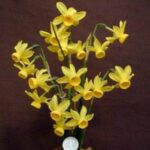
Division 5 – Triandrus Daffodils
Characteristics of N. triandrus clearly evident: usually two or more pendent flowers to a stem; perianth segments reflexed.
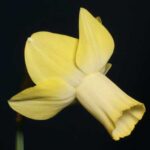
Division 6 – Cyclamineus Daffodils
Characteristics of N. cyclamineus clearly evident: one flower to a stem; perianth segments significantly reflexed; flower at an acute angle to the stem, with a very short pedicel (“neck”)
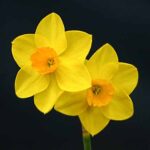
Division 7 – Jonquilla Daffodils
Characteristics of Sections Jonquilla or Apodanthi clearly evident: one to five (rarely eight) flowers to a stem; perianth segments spreading or reflexed; corona cup-shaped, funnel-shaped or flared, usually wider than long; flowers usually fragrant.
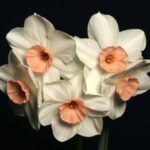
Division 8 – Tazetta Daffodils
Characteristics of Section Tazettae clearly evident: usually three to twenty flowers to a stout stem; perianth segments spreading not reflexed; flowers usually fragrant.

Division 9 – Poeticus Daffodils
Characteristics of N. poeticus and related species clearly evident; perianth segments pure white; corona very short or disc-shaped, not more than one-fifth the length of the perianth segments; corona usually with a green and/or yellow centre and red rim, but sometimes wholly or partly of other colours; anthers usually set at two distinct levels; flowers fragrant
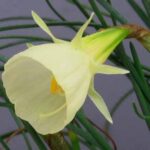
Division 10 – Bulbocodium Hybrids
Characteristics of Section Bulbocodium clearly evident: usually one flower to a stem; perianth segments insignificant compared with the dominant corona; anthers dorsifixed (ie attached more or less centrally to the filament); filament and style usually curved.
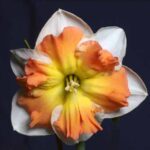
Division 11a – Split-Cupped Collar Daffodils
Split-corona daffodils with the corona segments opposite the perianth segments; the corona segments usually in two whorls of three.

Division 11b – Split-Cupped Papillon Daffodils
Split-corona daffodils with the corona segments alternate to the perianth segments; the corona segments usually in a single whorl of six.

Division 12 – Other Daffodil Cultivars
Consists of daffodils not falling into any of the previous categories. Many are inter-division hybrids.
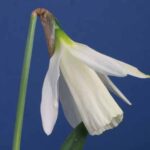
Division 13 – Daffodils distinguished solely by Botanical Name
Consists of the Species, Wild Variants, and Wild Hybrids found in natural daffodils.
Daffodil Colour Code System
Daffodils are are given a colour code to describe both the perianth (petal) colour and the cup colour. When looking at a ‘daffodil code’, the first number is the division used to categorize the daffodil. The letter or group of letters that follows the number, represents the perianth (petal) colour. The petal colour is described by beginning at the outside edge of the petal, then the middle, and lastly the inside part next to the corona. The second letter or group of letters represents the colour of the corona (trumpet or cup) starting from the eye-zone, then the mid-zone and extending out to the edge or rim.
See the photo/diagram below of Kiwi Happy Prince below as an example.
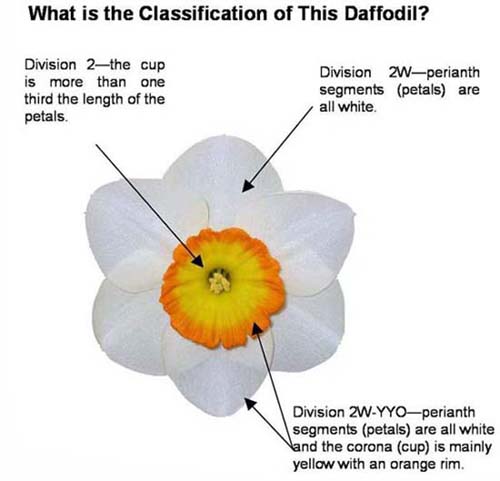
Kiwi Happy Prince, 2 W-YYO
The NDSNZ follows the Royal Horticulture Society’s daffodil classification system.
